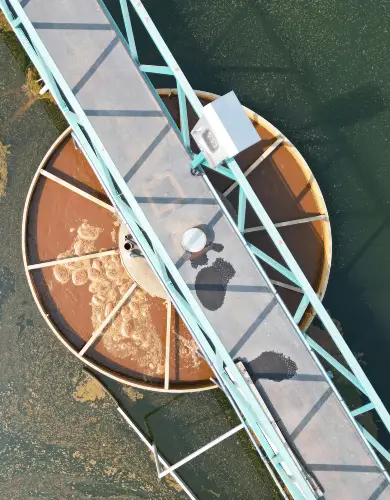What is Liquid Natural Gas (LNG)?
Since December 2021, energy prices across the UK and Europe have risen sharply due to a shortage of natural gas supplies.
Both are reliant upon imports of gas from its resource-rich neighbour Russia, who have the world’s most extensive reserves of natural gas, and a network of pipelines optimised to sell this gas directly to the European market.
Russia’s invasion of Ukraine triggered a series of economic sanctions between the West and Russia that have prompted European countries to move away from this supply. During 2023, imports were a quarter of what they were before the invasion (January 2023).
In 2023, European nations remain actively securing alternative gas imports in preparation for the winter months.
In this market, Liquid Natural Gas (LNG) has become crucial. Let’s dive in!
Contents
- What is Liquid Natural Gas (LNG) and how is it produced?
- Who uses Liquid Natural Gas (LNG)?
- What are the benefits of Liquid Natural Gas (LNG)?
- Why is LNG important to Britain?
- How much gas is still being imported from Russia?
- How have LNG imports to the UK changed since the Russian invasion of Ukraine?
- Should I fix my gas prices?
What is liquid natural gas (LNG)?
Liquid Natural Gas (LNG) is simply natural gas that has been cooled down to below minus 162 degrees celsius, where gas turns into liquid.
In its liquid state, natural gas takes up 600x less space than gaseous forms used in pipelines. It’s also safer as liquid gas is less combustible.
LNG is used to transport natural gas globally without requiring pipeline infrastructure, but using marine vessels, trains or trucks instead.
How is Liquid Natural Gas produced?
Natural gas extraction often occurs in remote locations as a byproduct of drilling for oil. In remote areas, building a gas pipeline can be prohibitively expensive. Previously, byproduct natural gas was just simply burnt off. LNG technology now allows the gas to be exported and sold in the form of liquid natural gas.
To be able to transport natural gas on a boat or by road, it’s necessary to cool the gas to change it into a liquid. This liquefaction process uses giant refrigerators to absorb the heat energy from natural gas.
The gas gradually cools, and when it reaches the negative 162 degrees Celsius, it undergoes a phase change into a liquid.
How is liquid natural gas used?
Liquid Natural Gas (LNG) is energy-dense and can be stored in huge tanks or transported in giant LNG tankers.
The biggest type of tanker is the ‘Q-MAX’ class that can safely carry up to 266,000 cubic meters of LNG, enough to power around 60,000 UK homes for a year.
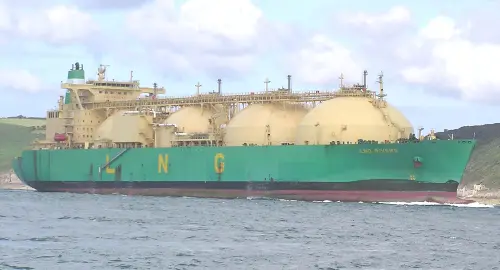
An LNG tanker safely stores liquid gas within large cryogenic tanks. Once an LNG tanker reaches its destination, it will offload the liquid natural gas at a regasification terminal.
A regasification facility turns Liquid Natural Gas back into a gaseous form where it moves across a country using a traditional gas pipeline network. This conventional gas infrastructure moves the gas to either a gas-fired power station to produce electricity or to be used directly by consumers (i.e. gas boilers and stoves).
Who uses Liquid Natural Gas (LNG)?
Liquid Natural Gas moves from countries that produce excess natural gas to those that need to import.
The world’s biggest producers of liquid natural gas are:
- The USA, where shale gas technology produces a glut of cheap natural gas. The US exports excess gas globally using liquefaction terminals on the Atlantic and Pacific coasts.
- Qatar is a small state that encompasses 14% of all the world’s natural gas reserves. Qatar exports LNG using liquefaction terminals on the Persian Gulf Coast.
- Australia is an isolated island with a vast surplus of gas reserves which it sells as liquid natural gas to the Asian market.
The world’s biggest importers of liquid natural gas are:
- Europe, a continent currently starved of its usual supply of natural gas from its neighbour Russia, is fast increasing its LNG regasification terminal capacity to allow more liquid natural gas imports.
- Japan, an isolated island with no natural gas resources, Japan imports its entire gas needs using regasification terminals.
- China, a vast country with a fast-growing economy produces much less gas than it consumes. The import of LNG from the Middle East and Australia is becoming a growing component of China’s energy needs.
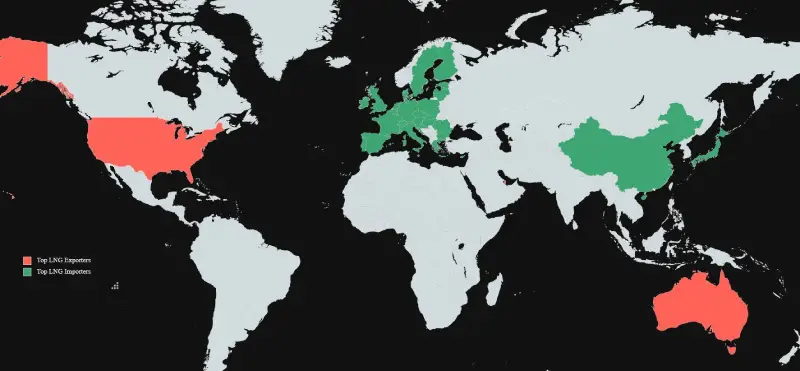
What are the benefits of Liquid Natural Gas (LNG)?
The main benefits of using Liquid Natural Gas (LNG) are:
- It’s convenient to transport long distances using international shipping.
- Unlike natural gas transported by pipelines, LNG transportation is more flexible and routes can be changed with little notice. The difference is akin to travelling within a train network or by car on the road network.
- It’s easily converted back into a gaseous form to generate electricity.
- Natural gas, derived from LNG is the most environmentally friendly fossil fuel, producing 45% less damaging emissions than coal.
- It’s safer to store as it’s not combustible in liquid form.
- There are over 200 years of remaining gas reserves available globally based on current consumption and known gas reserves.
Why is LNG important to Britain?
Back in the 1990’s Britain enjoyed energy independence, where the North Sea gas fields produced more gas than the country used.
Despite recent projects such as Jackdaw, North Sea gas production is declining. The UK now relies on natural gas imports to meet domestic demand.
On top of this, Britain has recently decommissioned many of its strategic natural gas storage facilities, including its largest one: “Rough gas storage facility” in Yorkshire.
The consequence is that Britain has become very sensitive to the price and availability of natural gas imports via pipelines, and the price spike due to the Russian invasion of Ukraine forced the UK to purchase LNG to guarantee gas demand is met.
To accept liquid natural gas, the UK has developed liquefaction facilities in Milford, South Wales and Kent, allowing gas import from LNG tankers. These facilities enable the UK to purchase gas from America and the Middle East without relying on Russia’s exports (Australia is too far!).
The LNG terminals connect to the British gas distribution network that moves the natural gas to power stations and to end users in homes and businesses.
Being able to circumvent the need to purchase gas from Russia is politically significant as it deprives Russia of economic leverage with the ability to starve Britain of gas supplies.
How much gas is still being imported from Russia?
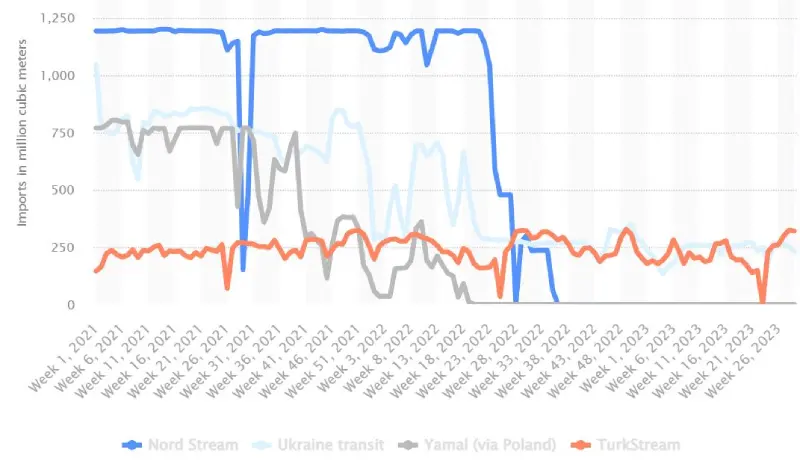
The graph clearly shows how Russian gas imports into Europe and the UK have significantly decreased since the Ukraine invasion (early 2022).
Since the invasion, the Nord Stream and Yamal pipeline imports have dropped to zero, with the remaining Russian gas coming from TurkStream and via transit through Ukraine (ironically).
According to statista, Imports are roughly a quarter of what they were pre-invasion:
- ~550 million cubic meters per week in August 2023, compared to
- ~2,000 million cubic meters per week in January 2022, prior to the invasion.
How have LNG imports to the UK changed since the Russian invasion of Ukraine?
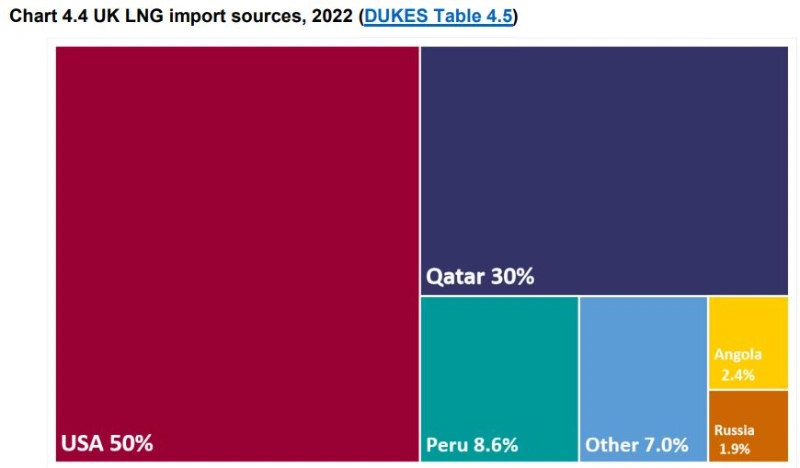
According to DUKES, LNG in 2022 accounted for almost half of total gas imports, with more records being broken as a result of the invasion:
- The US became the number one LNG exporter to the UK, overtaking Qatar for the first time.
- LNG was sourced from a record 13 countries, including afar sources like Peru, which doubled its LNG exports to the UK.
In fact, the total amount of LNG imports increased by a whopping 74 compared to 2021, although this has dropped back to its pre-pandemic levels during the summer of 2023 (winter is coming though…).
Effects on domestic consumption
In combination with a relatively warm winter, the record business gas prices in the UK have led to an 18% reduction in domestic natural gas consumption compared to 2021. Less drastic, but similar patterns were seen across all UK sectors.
Should I fix my gas prices for 2025?
If your UK business has premises that consume gas, we suggest you read our in-depth article answering the question that comes to every business owner’s mind before the winter: “Should I fix my energy prices until 2025?”
If you are simply looking to compare business energy deals, use our online services:

